Gujarat Board GSEB Textbook Solutions Class 7 Science Chapter 14 Electric Current and its Effects Textbook Questions and Answers, Notes Pdf.
Gujarat Board Textbook Solutions Class 7 Science Chapter 14 Electric Current and its Effects
Gujarat Board Class 7 Science Electric Current and its Effects Textbook Questions and Answers
Question 1.
Draw in your notebook the symbols to represent the following components of electrical circuits: connecting wires, switch in the ‘OFF’ position, bulb, cell, switch in the ‘ON’ position, and battery.
Answer:
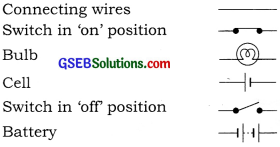
Question 2.
Draw the circuit diagram to represent the circuit shown in fig.

Answer:

Question 3.
This Figure shows four cells fixed on aboard. Draw lines to indicate how you will connect their terminals with wires to make a battery of four cells.
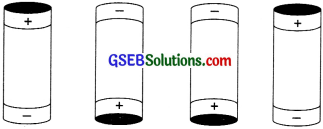
Answer:

The positive terminals of the cell will be connected to the negative terminal of the cell and vice versa with the wire to make it a battery.
![]()
Question 4.
The bulb in the circuit shown in fig. does not glow. Can you identify the problem? Make necessary changes in the circuit to make the bulb glow.

Answer:
The problem in this circuit is the combi¬nation of two cells. In the circuit positive terminal of one cell should be connected with the negative terminal of others to make the bulb glow.
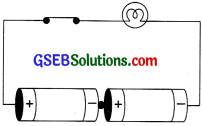
Question 5.
Name any two effects of electric current.
Answer:
Electric current has the following effect:
- Electric current can give rise to heating and lighting.
- Electric current can convert a straight conductor into a temporary magnet.
Question 6.
When the current is switched on through a wire, a compass needle kept nearby gets deflected from its north-south position. Explain.
Answer:
When current is passed through the wire, it deflects the compass near it from its north-south position like a magnet. This is called the magnetic effect of the current. As we know the needle of the compass is made up of a thin magnet. When this needle comes in contact with another magnet then the like poles of the magnet repel each other and opposite poles attract each other. So the deflection is seen in the needle. In this case, the wire behaves like a magnet and causes a deflection in the needle of the compass.
![]()
Question 7.
Will the compass needle show deflection when the switch in the circuit shown by fig. is closed?

No, because there is no source of electric current in this circuit, i.e., there is no battery.
Question 8.
Fill in the blanks:
(a) Longer line in the symbol for a cell represents its …………. terminal.
(b) The combination of two or more cells is called a ………..
(c) When current is switched ‘on’ in a room heater, it ………….
(d) The safety device based on the heating effect of electric current is called a …………
Answer:
(a) positive
(b) battery
(c) becomes red hot and emits heat
(d) fuse.
Question 9.
Mark ‘T’ if the statement is true and ‘F’ it is false:
(a) To make a battery of two cells, the negative terminal of one cell is connected to the negative terminal of the other cell. (T/F)
(b) When the electric current through the fuse exceeds a certain limit, the fuse wire melts and breaks. (T/F)
(c) An electromagnet does not attract a piece of iron. (T/F)
(d) An electric bell has an electromagnet. (T/F)
Answer:
(a) False
(b) True
(c) False
(d) True
![]()
Question 10.
Do you think an electromagnet can be used for separating plastic bags from a garbage heap? Explain.
Answer:
No, the plastic bags do not get attracted by the magnet, so they cannot be separated by an electromagnet. Plastic bags are not magnetic materials, only magnetic materials like iron can be attracted by the magnet.
Question 11.
An electrician is carrying out some repairs in your house. He wants to replace a fuse by a piece of wire. Would you agree? Give reasons for your response.
Answer:
No, we would not agree to allow to replace the fuse by a wire. Wires in the fuses are of specific melting points. So we should always use ISI marked fuses in our houses to prevent short circuits.
Question 12.
Zubeda made an electric circuit using a cell holder shown in given fig. a switch and a bulb. When she put the switch in the ‘ON’ position, the bulb did not glow. Help Zubeda in identifying the possible defects in the circuit.
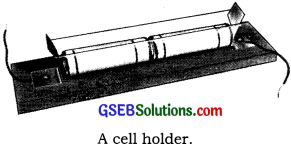
Answer:
It is important to put the cells in the right series. The positive terminal of the first cell should be connected with the negative terminal of the second cell. The switch should be closed properly and the bulb should not be fused. If Zubeda will check these then the bulb will certainly glow.
![]()
Question 13.
In the circuit shown in fig.

- Would any of the bulb glow when the switch is in the ‘OFF’ position?
- What will be the order in which the bulbs A, B, and C will glow when the switch is moved to the ‘ON’ position?
Answer:
- No bulb will glow.
- All bulbs will glow simultaneously.
Extended Learning Activities And Projects
Question 1.
Set up the circuit shown above in Fig. of NCERT again. Move the key to ‘ON’ position and watch carefully in which direction the compass needle gets deflected. Switch ‘OFF’ the current. Now keeping the rest of the circuit intact, reverse the connections at the terminal of the cell. Again switch ‘on’ the current. Note the direction in which the needle gets deflected. Think of an explanation.
Answer:
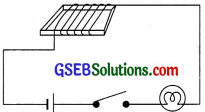
We observe that when key is on position then the compass needle gets deflected in one direction. The needle comes to its original position when current is switched off. When we change the direction of current the direction of the deflection of the compass needle also changed. This activity shows:
- Electricity shows a magnetic effect.
- If the direction of the current is changed then the direction of the magnetic field also changes.
![]()
Question 2.
Make four electromagnets with 20, 40, 60, and 80 turns. Connect them one by one to a battery of 2 cells. Bring the electromagnet near a box of pins. Count the number of pins attracted by it. Compare the strengths of the electromagnets.
Answer:
Students count the pins themselves. If we compare the strength of different electromagnets having 20, 40, 60, and 80 turns the electromagnet having 80 turns has the largest strength. This activity shows that:
Strength of magnet ∝ Number of turns
Question 3.
Using an electromagnet, you can make a working model of a railway signal as shown in Fig.

Answer:
Do it yourself
Question 4.
Visit an electric shop. Request a mechanic to show you the various types of fuses and MCB and to explain how they work.
Answer:
The fuses and MCB both work on the basis of the heating effect of current. They set up at a particular amount of current. If the number of current increases beyond a limit, they cut off the circuits.
![]()